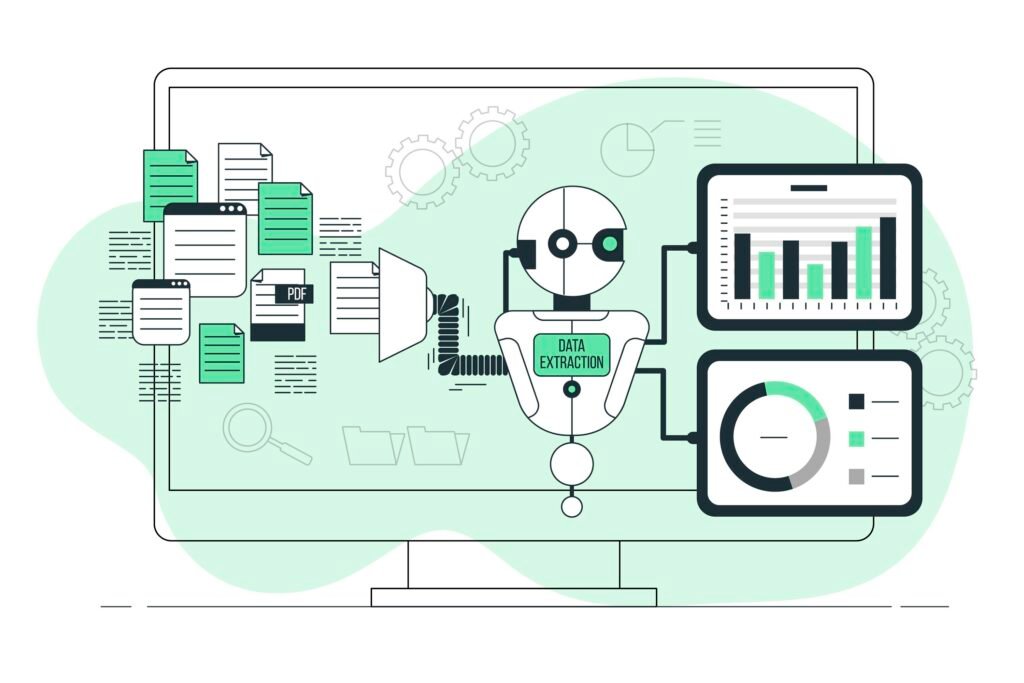Machine Learning in Business Analytics: Practical Application, Benefits, Trends
5 Mar 2024
Igor Kelly

Machine learning is a part of artificial intelligence that relies on systems learning from data, identifying patterns, and making decisions with minimal human input. With advanced data analytics using machine learning algorithms, organizations can gain a competitive edge by extracting actionable insights and predictive models from complex data streams.
In this article, we will discover the benefits and challenges of AI integration in business analytics, examine artificial intelligence applications in analytics across different industries, and make a few predictions about the technology’s future.
Applications of Machine Learning Methods in Business Analytics
Machine learning trains algorithms to find patterns and correlations in large data sets and make the best decisions and predictions based on this analysis. Machine learning improves with use and helps to produce more accurate insights. The algorithms operate in various ways – let’s look at the key ones below.
1. Decision analytics helps evaluate critical business choices, employing diverse parameters and considering psychological, managerial, training, and economic factors to inform the decision-making process effectively. Its primary objective is to classify decisions featuring multiple alternative courses of action and their corresponding outcomes through a rational lens. Data-driven decision-making with machine learning is applied in the following business areas:
- Strategic management: Decision analytics enables businesses to assess competitive positioning and optimize resource allocation. By integrating machine learning with business intelligence, businesses can evaluate market dynamics and competitor strategies, allowing them to strategically allocate resources and strengthen their competitive positioning in the global marketplace.
- Marketing optimization: In marketing, decision analytics empowers organizations to conduct precise market segmentation analysis and optimize campaign strategies, maximizing return on investment and enhancing customer engagement.
- Capital allocation and risk management: Within capital areas, decision analytics facilitates the optimization of investment portfolios and enables thorough risk assessment, empowering businesses to make sound financial decisions and mitigate potential risks effectively.
2. Descriptive analytics encompasses examining historical data to establish and assess various metrics, utilizing data aggregation and data mining processes to identify patterns within the dataset. While primarily retrospective, descriptive analytics aids in strategic decision-making by offering insights into past events rather than predicting future outcomes. Here are a few examples of how it is applied:
- Retail: Descriptive analytics aids in analyzing sales trends and customer purchasing behaviors, optimizing inventory management, and refining marketing strategies for enhanced customer engagement.
- Healthcare: In the healthcare sector, descriptive analytics enables the evaluation of patient demographics and treatment outcomes, facilitating improved care delivery, resource allocation, and patient satisfaction.
- Manufacturing: Within manufacturing, descriptive analytics improves production processes and quality control measures. ML in business analytics identifies room for improvement and drives cost savings.
3. Predictive analytics harnesses the power of algorithms and machine learning to extrapolate future events and trends from historical and present data. By discerning patterns and tendencies, predictive analytics aims to anticipate forthcoming behaviors, enabling businesses to proactively identify opportunities and mitigate risks effectively. Business intelligence and AI benefit various industries, such as:
- Finance: Predictive analytics assists in forecasting market trends, optimizing investment strategies, and mitigating financial risks, thereby enhancing portfolio performance.
- Publishing: Within the publishing industry, predictive analytics and AI enable the analysis of reader preferences, trends in book consumption, and forecasting of bestseller potential, aiding publishers in making strategic decisions regarding content creation across different distribution channels.
- Retail: Predictive analytics empowers retailers to forecast consumer demand, optimize inventory levels, and tailor marketing campaigns, driving sales growth.
4. Prescriptive analytics extends beyond predictive models by providing actionable recommendations and decisions derived from structured and unstructured data from internal and external sources. By leveraging data mining for business insights, prescriptive analytics aims to guide companies toward making optimal decisions while minimizing collateral risks. Here are the possibilities AI in business analytics open for businesses:
- Content streaming platforms: Prescriptive analytics assists content streaming platforms in recommending personalized content to subscribers, optimizing retention and subscription renewals. Automated decision support systems in business analytics help increase revenue streams and competitiveness in the market.
- Software as a Service (SaaS) companies: Within SaaS businesses, prescriptive analytics guides product development based on user behavior and feedback, reducing churn rates and enhancing overall product performance.
- Subscription box services: Prescriptive analytics enables subscription box services to analyze customer preferences and curate personalized product offerings. AI-driven customer analytics optimize inventory management, simultaneously driving subscription renewals and revenue growth.
Case Studies of ML-powered Business Analytics Across Various Domains
Leveraging AI for competitive advantage in analytics has become a widespread practice. Through these real-world examples, we explore how ML-driven applications have reshaped industries and their approach to addressing frequent challenges.
| Industry | Challenge | Why ML? | ML implementation outcomes |
| Customer Relationship Management (CRM) | A multinational retail corporation faced challenges in understanding customer preferences and predicting buying behavior across diverse demographics and channels. | The business required predictive analytics and machine learning to personalize customer interactions and enhance customer satisfaction, ultimately driving sales and loyalty. | The company analyzed historical customer data using ML algorithms to develop personalized recommendation systems. As a result, they experienced a significant increase in customer engagement, higher conversion rates, and improved customer retention. |
| Supply Chain Management | A global manufacturing company struggled with inefficient inventory management and supply chain disruptions due to unpredictable demand fluctuations and supplier delays. | The business sought predictive modeling for business optimization, capable of forecasting demand accurately, optimizing inventory levels, and mitigating supply chain risks proactively. | Business analytics transformation with machine learning enabled the company to analyze historical sales data, market trends, and external factors influencing demand. By accurately forecasting demand and optimizing inventory levels, they minimized stockouts, reduced carrying costs, and improved overall supply chain efficiency. |
| Marketing | A digital marketing agency faced difficulties in identifying high-value customer segments. The company struggled to analyze diverse datasets, including customer demographics, behaviors, and interactions across multiple channels, to accurately pinpoint segments with the highest potential for conversion. | The agency required advanced AI software development solutions to analyze large volumes of customer data, identify behavioral patterns, and optimize marketing strategies for enhanced targeting and conversion. | Leveraging AI in business analytics, the agency analyzed customer interactions, demographics, and campaign performance data to identify high-value segments and tailor personalized marketing campaigns. As a result, they achieved higher campaign ROI, increased conversion rates, and improved customer engagement in the desired segment. |
| Finance | A financial institution encountered challenges detecting fraudulent activities and mitigating financial risks associated with credit card transactions and loan approvals. | AI-enabled risk management in business analytics had the potential to identify suspicious patterns and enhance fraud detection capabilities to safeguard financial assets and maintain regulatory compliance. | By harnessing AI for data-driven business solutions, the institution began to analyze transactional data in real time to identify fraudulent activities and flag suspicious transactions for further investigation. The ML-powered fraud detection system significantly reduced false positives, minimized financial losses due to fraud, and enhanced overall customer security and trust. |
| Risk Management | An insurance company faced difficulties in assessing and pricing risks accurately across diverse policyholders and insurance products, leading to underwriting losses and increased claims expenses. | The company required advanced risk analytics capabilities to analyze complex data patterns, predict claim probabilities, and optimize underwriting and pricing strategies to improve profitability and competitiveness. | Implementing machine learning models, the company analyzed historical claims data, policyholder demographics, and risk factors to develop predictive risk models. By accurately assessing risks and pricing policies, they minimized underwriting losses, optimized claim reserves, and improved overall profitability and risk management effectiveness. |
These are just a few examples of how artificial intelligence in business analytics allows businesses to uncover intricate patterns and insights from vast datasets, driving informed decision-making and strategic planning. Such diversity hints that the spread of ML among them is only the beginning. However, there also are disadvantages – let’s examine the most obvious ones.
Challenges in Integrating Machine Learning
Machine learning enables companies to gain a competitive advantage by solving problems and uncovering insights faster and easier than conventional analytics. However, like any innovative technology, ML presents businesses with challenges, the ways to deal with which may not be evident at first glance.
1. Biases and errors: Machine learning applications are susceptible to human and algorithmic biases, leading to false correlations and contaminated results.
Mitigation tip: Prioritize diverse data sources and regularly audit and update algorithms to detect and rectify biases.
2. Black Box models: Complex machine learning models often result in so-called black box models, where humans cannot explain or understand algorithm outputs.
Mitigation tip: Invest in interpretability techniques and tools to enhance transparency and provide insights into model workings, fostering trust among stakeholders.
3. Complexity and transparency: The complexity of machine learning models poses risks for companies unable to discern how and why specific results or decisions were reached.
Mitigation tip: Implement transparency measures and tools that improve visibility into model processes, enabling stakeholders to understand and trust the outputs.
4. Ethical considerations: Ethical considerations related to ML use, including privacy violations, discriminatory outcomes, and unintended consequences, pose significant challenges for many businesses that are unaware of the governing legislation.
Mitigation tip: Establish comprehensive ethical guidelines and frameworks, conduct thorough impact assessments, and prioritize fairness and accountability in machine learning deployment.
5. Evolution of risk management: As data sets and algorithms of machine learning in business analytics increase in complexity, risk management tools and resources also evolve – which implies a major lack of specific skills across the companies.
Mitigation tip: Proactively establish robust AI governance policies and best practice protocols to combat errors and biases, ensuring the integrity and reliability of machine learning systems.
While integrating machine learning for business analytics offers significant benefits, addressing challenges related to biases, errors, model complexity, and ethical considerations is essential. By implementing proactive risk management strategies and fostering transparency, businesses can leverage the full potential of machine learning. Business analysis services can mitigate collateral risks and maximize the value of analytics-driven insights.
Future Trends in Business Analytics with Machine Learning
Integrating machine learning in business analytics revolutionizes data-driven strategies, enabling organizations to optimize operations, personalize customer experiences, and anticipate market trends. The most promising ones include:

- Continuous learning and adaptation: Future trends in machine learning for business analytics will emphasize dynamic adaptation to changing market behaviors, improving performance with expanding data volumes. This trend’s application lies in enabling agile responses to evolving market dynamics. AI-driven market intelligence is a key to ensuring sustained competitiveness.
- Enhanced personalization and customization: Future trends include greater personalization and customization capabilities in machine learning algorithms, tailoring solutions precisely to individual goals and needs. AI-driven insights for business strategy will soon become irreplaceable for E-commerce and digital marketing sectors, driving higher engagement and conversion rates.
- Integration of AI with IoT: Integrated with the IoT ecosystem, machine learning algorithms for predictive modeling will enable unprecedented operational efficiency and predictive maintenance. This trend’s application spans industries such as manufacturing and healthcare, optimizing outcomes and improving efficiency.
Conclusion
All types of machine learning in business analytics have advantages and disadvantages, with some being more suitable for a particular task while producing completely inaccurate results on another.
In our AI software development solutions, we go through a meticulous research phase with our machine learning methods to ensure that you receive the most future-proof option. Are you curious about how you can turn your historical sales data into actionable insights that lead to more sales? Arrange a short appointment with us today.